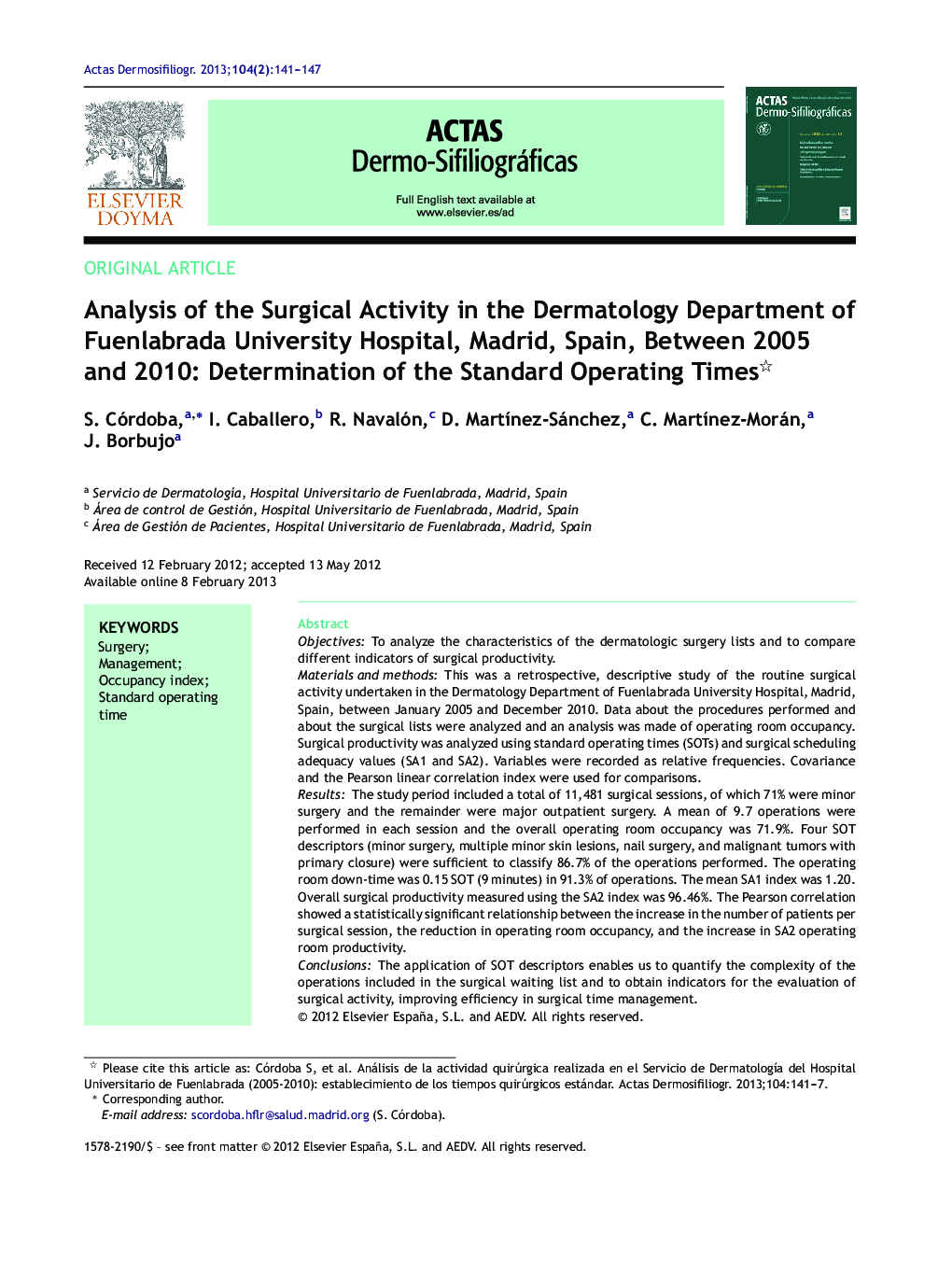| کد مقاله | کد نشریه | سال انتشار | مقاله انگلیسی | نسخه تمام متن |
|---|---|---|---|---|
| 3183235 | 1200690 | 2013 | 7 صفحه PDF | دانلود رایگان |

ObjectivesTo analyze the characteristics of the dermatologic surgery lists and to compare different indicators of surgical productivity.Materials and methodsThis was a retrospective, descriptive study of the routine surgical activity undertaken in the Dermatology Department of Fuenlabrada University Hospital, Madrid, Spain, between January 2005 and December 2010. Data about the procedures performed and about the surgical lists were analyzed and an analysis was made of operating room occupancy. Surgical productivity was analyzed using standard operating times (SOTs) and surgical scheduling adequacy values (SA1 and SA2). Variables were recorded as relative frequencies. Covariance and the Pearson linear correlation index were used for comparisons.ResultsThe study period included a total of 11,481 surgical sessions, of which 71% were minor surgery and the remainder were major outpatient surgery. A mean of 9.7 operations were performed in each session and the overall operating room occupancy was 71.9%. Four SOT descriptors (minor surgery, multiple minor skin lesions, nail surgery, and malignant tumors with primary closure) were sufficient to classify 86.7% of the operations performed. The operating room down-time was 0.15 SOT (9 minutes) in 91.3% of operations. The mean SA1 index was 1.20. Overall surgical productivity measured using the SA2 index was 96.46%. The Pearson correlation showed a statistically significant relationship between the increase in the number of patients per surgical session, the reduction in operating room occupancy, and the increase in SA2 operating room productivity.ConclusionsThe application of SOT descriptors enables us to quantify the complexity of the operations included in the surgical waiting list and to obtain indicators for the evaluation of surgical activity, improving efficiency in surgical time management.
ResumenObjetivoAnalizar las características de las jornadas quirúrgicas dermatológicas y comparar distintos indicadores de rendimiento quirúrgico.Material y métodoEstudio descriptivo y retrospectivo de la actividad quirúrgica programada realizada en el Servicio de Dermatología del Hospital Universitario de Fuenlabrada desde enero de 2005 a diciembre de 2010. Se analizan datos relativos a los procedimientos realizados y a las jornadas quirúrgicas. Se analizan los índices de ocupación, de rendimiento quirúrgico mediante tiempos quirúrgicos estándar (TQE) y los valores de adecuación quirúrgica AQ1 y AQ2. La medición de las variables se realiza mediante frecuencias relativas. Se ha calculado la covarianza y el índice de correlación lineal de Pearson entre distintas variables.ResultadosDurante el periodo de estudio se realizaron 11.481 jornadas quirúrgicas. El 71% de las jornadas fueron de cirugía menor y el resto de CMA. La media de pacientes intervenidos/jornada fue de 9,7. El índice global de ocupación de quirófano fue del 71,91%. Cuatro descriptores TQE: «cirugía menor», «lesiones múltiples menores de piel», «cirugía de la uña» y «tumor maligno de piel cierre directo» fueron suficientes para clasificar el 86,7% de las cirugías realizadas. El 91,3% de las intervenciones asociaron un tiempo muerto de TQE 0.15 (9 min). La media del indicador AQ1 fue de 1,20. El rendimiento de quirófano global medido mediante el indicador AQ2 fue del 96,46%. El índice de correlación de Pearson mostró relación estadísticamente significativa entre el incremento del número de pacientes/jornada, la disminución del índice de ocupación y el aumento del rendimiento de quirófano AQ2.ConclusionesLa aplicación de los descriptores TQE permite cuantificar la complejidad de los procesos incluidos en LEQ y obtener indicadores para evaluar la actividad quirúrgica, mejorando la eficiencia en la gestión de los tiempos quirúrgicos.
Journal: Actas Dermo-Sifiliográficas (English Edition) - Volume 104, Issue 2, March 2013, Pages 141–147